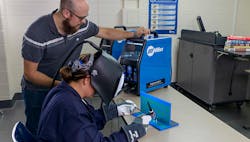Addressing the Welder Shortage with Technology
In the average welding operation, 85 percent of costs are related to labor, which makes labor a critical factor impacting productivity and the bottom line. But manufacturers face some startling numbers regarding labor: The American Welding Society (AWS) estimates there will be a shortage of nearly 400,000 welding operators in the industry by 2024.
The shortage is being felt across all sectors of welding — from fabrication and construction to manufacturing. For employers, this can mean missing deadlines or productivity targets, a reduced ability to take on more work, or cost increases in the operation due to added rework and scrap stemming from less-experienced welding operators.
This industry trend is driven by a few factors. Welding operators of the baby-boom generation are reaching retirement age while fewer people are choosing careers in the trades, including welding.
Advancements in technology can help fill this gap. Welding equipment manufacturers are stepping up with a variety of solutions that can help companies address the welding operator shortage.
How are companies impacted?
Struggling to find enough welders to fill open jobs is one obvious impact. Another challenge for employers is the lack of experience of new welding operators coming into the trade. Beyond the first step of finding qualified employees, companies then must train them to ensure they’re properly prepared to weld in a manufacturing environment. This training can be a lengthy process and requires investing additional time, money and effort.
Both of these factors impact a company’s ability to remain competitive by completing projects on time while maintaining high quality — as well as their ability to grow and take on more work.
Welding equipment manufacturers have three key solutions to help companies address these challenges.
No. 1: Easy-to-use welding equipment
Welding machines that are easy to use help shorten the training time for inexperienced welding operators and provide a better user experience. Much of the welding equipment on the market today is designed for quick and easy setup, with a focus on push-button operation and an intuitive interface.
This helps new operators get up to speed faster — which improves the training process and gets them into production welding faster.
It also helps operators improve their productivity once they are on the job by making it easier to choose the correct settings or change parameters when necessary.
Look for welding power sources that have intuitive single point-of-use controls that are used to set up and adjust all the welding parameters and features of the equipment.
The technology available in some welding power sources also offers full control of welding parameters remotely via a wire feeder or remote. This provides the ability to easily change welding parameters with the push of a button at the weld joint — saving the operator time and improving safety on jobsites.
In addition, some welding systems are designed to help operators with setup based on the type and thickness of material being welded — to ensure correct parameters are used.
No. 2: Arc performance
Welding equipment manufacturers are also focusing on the technology inside the machine that can make an operator’s job easier. Some welding power sources use advanced arc technology that helps the operator produce high-quality welds.
These advanced arcs, which were first commonly adopted in large industrial manufacturing environments such as automotive and heavy equipment, are becoming more accessible to mid-size companies in the general welding industry. They are especially beneficial in applications that require welding new lightweight, high-strength materials being adopted in more industries.
Pulsed MIG options have a wider operating window that makes the process more forgiving and adaptive to assist in compensating for operator variations. The adaptive nature of these arcs results in the ability to vary stickout, torch angle and travel speeds without negatively impacting weld quality or mechanical properties of the completed weld.
This makes it easier for less experienced welding operators to produce quality welds faster and more consistently.
Pulsed MIG options also reduce the chance of distortion, spatter and burn-through due to the faster travel speeds and wire feed speeds, which reduce heat input and decrease stress on the base metal. Improved directional control in the weld puddle also provides more control over the bead profile and improved arc starting and stopping.
Some power sources make synergic adjustments — the operator adjusts one knob, while the machine simultaneously adjusts multiple parameters or settings automatically to produce the desired arc characteristics. This simplifies setup and prevents the automated system from welding with less-than-ideal welding parameters.
No. 3: Training and assessment solutions
Training and assessment solutions are an option that can help new and experienced operators improve — and they allow companies to monitor performance and output over time.
Virtual reality and welding simulation solutions are one answer, offering cost savings and efficiency in welder screening and training. Available systems on the market simulate MIG, TIG, flux-cored and stick welding processes, blending real-world and computer-generated images into an augmented reality environment for a realistic welding simulation that closely resembles live arc welding.
To the user this looks and sounds like actual welding — complete with metal workpieces, welding arcs and weld beads — but it saves companies money and resources because they are not consuming coupons, wire or gas.
These solutions can deliver real-time feedback that helps correct errors, reinforce proper technique and accelerate skill advancement prior to actual live arc welding in a lab.
A virtual reality and welding simulation training solution also helps create awareness of opportunities and attract computer-savvy applicants to welding programs, compared to traditional classrooms that may not always capture the imagination of students who grew up with smart technology.
Once new welding operators are trained and on the job, utilizing welding information management systems allows companies to conduct ongoing assessment and training.
These welding information management systems can provide data on quality, productivity, arc-on time and many other factors in the welding operation — allowing companies to identify continuous improvement initiatives for new and seasoned welding operators alike.
Closing the gap with technology
In the quest to recruit and train more welding operators to meet current and future industry demands, new technologies and equipment will be an important part of the solution.
Available technologies on the market can help companies transform their screening, recruiting and training processes for welding, while welding power sources and processes today are easier and more intuitive for operators to use than ever before — saving time, money and resources.





